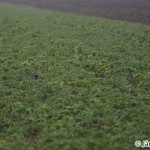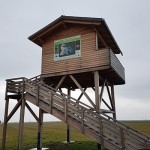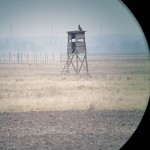Great bustard in winter
January 11 – 13, 2018
We apologise, but due to not having enough capacities, we were not able to write our trip reports for quite a considerable time (although we have done a few).
During last couple of days, we have spent time at the wintering place of our heaviest flying bird – the magnificent Great bustard (Otis tarda). Wintering grounds are found not far from our capital city Bratislava (whole Great bustard observation was done in compliance with Slovak Nature and Landscape Protection Act, as well as taking specifically this species´ protection into account). We were privileged to host Mrs. Vymazalová, who has been (alongside her “daddy“, Ladislav Fiala) dealing with Great bustard protection in Znojmo area in Czech Republic for many years.
We started our observation from Slovak side. Almost immediately we saw four specimens flying towards nearby agricultural fields. On our way back we spotted a flock of approx. 77 Common linnets (Linaria cannabina).

We continued to our next spot at Slovak’s side, where we were lucky to observe much bigger flock of bustards (we estimated their number to approx. 81 birds). As we were convinced, that the opposite side of their wintering area may hold even more birds, we moved through Hungary to Austria. Here we were able to observe them even better. We visited two watchtowers specifically built to Great bustard observations. At one of them we saw a Hen harrier (Circus cyaneus) attacking (in Slovakia) more and more uncommon Grey partridge (Perdix perdix). Although we had seen them there quite often in the past, this combination of birds is not a common sight in Slovakia.
During one of our transfers we spotted a bird of prey. After coming a little bit closer we positively identified this as an adult Imperial eagle (Aquila heliaca).
After this we stopped at even bigger flock of foraging Great bustards. And when another approx. 80 birds joined this flock, we were able to estimate their number to roughly 194. When taking our first four from a different area into account, the total number of these heavyweights was roughly 194 – 198 specimens. It was most definitely the biggest number of Great bustards we were able to see during whole three day observation process.
After this great spectacle we moved to another place, much more used by bustards during their mating and nesting season. We were not lucky to see any of them, but spotted three White-tailed eagles (Haliaeetus albicilla) quarrelling over some prey. Not far from them were also Stock doves (Columba oenas).
The end of our trip was Danube river’s Hrusov dam, where we observed beautiful male Common goldeneyes (Bucephala clangula) displaying in front of their female counterparts. We saw also much more uncommon Smews (Mergellus albellus) and later on even rarer Velvet scooters (Melanitta fusca) and Greater scaups (Aythya marilla). It surely was a great ending to our Great bustard observation trip.
Due to strict protection of this species and its conservation, walking in this Bird protection area is strictly forbidden outside marked tourist paths. We kindly advise visitors to respect it.

























